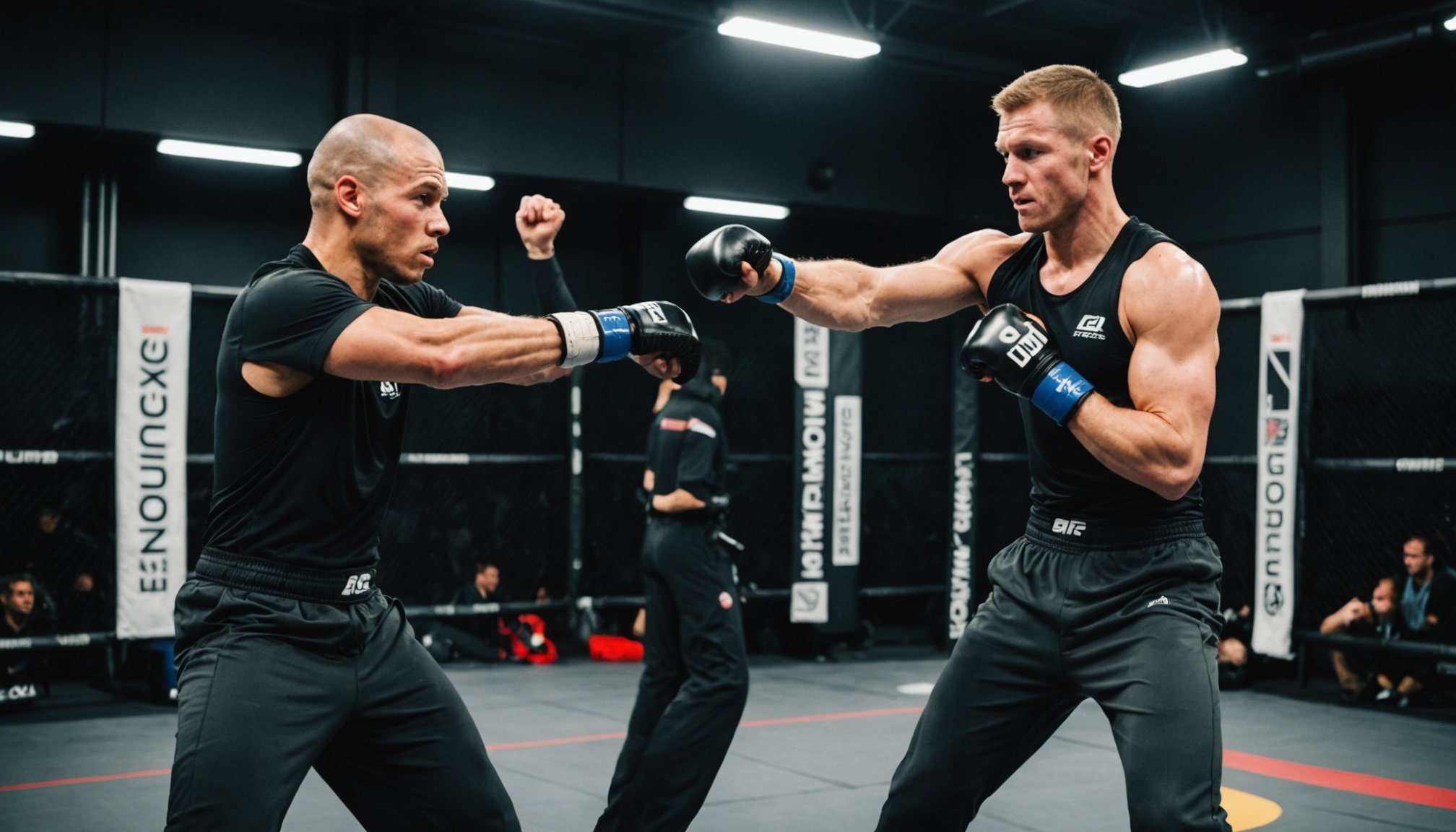Understanding Biomechanics in Sports Training
Biomechanics in sports plays a crucial role in enhancing athletic performance by understanding and applying the principles of physics to movement. At its core, biomechanics involves the study of forces and their effects on the human body, enabling athletes to optimize their training techniques for improved efficiency and power. These insights are particularly valuable in developing effective defense strategies in sports where precision and timing are paramount.
Historically, biomechanics has been integral to martial arts, informing the development of techniques by dissecting movements into analyzable components. This historical context emphasizes how martial artists have long benefited from a deeper understanding of biomechanics in sports, not just for offensive capabilities, but also for mastering defensive maneuvers.
This might interest you : Top Nutrition Hacks for Rapid Muscle Recovery: Vital Tips for UK Combat Sports Athletes
Enhancing defensive skills through biomechanics requires a focus on body mechanics and spatial awareness. Athletes use insights from biomechanical analysis to perfect their stance, balance, and movement efficiency, providing them with a strategic advantage. By incorporating biomechanical principles into training techniques, athletes can anticipate opponents’ actions and defense strategies more effectively. Moreover, integrating these principles helps in injury prevention, ensuring the athlete optimizes their performance while maintaining long-term health.
The Science of Movement
Movement science is at the heart of optimizing athlete performance, focusing on the interaction between biomechanics and kinetic analysis. Understanding foundational kinetic principles enables athletes to execute precise defensive maneuvers effectively. This includes the study of motion dynamics such as force application, balance, and reaction time, which are critical in sports involving intricate defensive strategies.
Have you seen this : Boosting Recovery in UK Combat Sports: The Crucial Role of Heart Rate Variability for Optimal Performance
Principles of Kinetics
Kinetics involves analyzing how forces influence movement. For athletes, understanding these principles helps refine their defensive capabilities. Key factors include momentum control and centre of mass, crucial for maintaining balance during quick directional changes. By studying kinetics, athletes can learn how to harness and redirect motion, transforming potentially vulnerable positions into tactical advantages.
Analyzing Fighter Movements
Motion capture technology is a pivotal tool in kinetic analysis. By tracking an athlete’s movements in real-time, coaches can dissect every aspect of their technique. Identifying inefficient or erroneous movement patterns allows for targeted adjustments, ultimately enhancing their defensive prowess. This technology offers a detailed perspective on an athlete’s form, helping fine-tune their responses to opponents.
Tools for Measurement in Training
Tools like motion capture and force plates offer valuable insights into the mechanics of an athlete’s movements. Such technologies provide metrics essential for optimizing biomechanics in sports training, revealing aspects like force distribution and joint angles. Utilizing these measurements, athletes refine their techniques, improve training outcomes, and bolster their overall defense strategies.
Innovative Training Techniques
In the realm of sports, biomechanically-informed training innovations are reshaping how athletes, particularly fighters, refine their defensive drills. By focusing on biomechanics, these drills leverage precise movement analysis to enhance agility and reaction time. Fighters are equipped to mitigate offensive attacks with a blend of technique and strategy built from scientific data.
For instance, incorporating strength training into defensive regimens amplifies these biomechanical benefits. By improving muscle power and endurance, athletes can execute quick responses to opponents, maintaining a robust defensive posture. This integration isn’t limited to general exercises; it involves targeted strength routines specific to movements critical in defensive tactics.
Moreover, adapting defensive drills based on biomechanical insights results in more nuanced training. Drills tailored to simulate real-life scenarios allow athletes to practise rapid decision-making and reflexes, grounded in their understanding of body mechanics.
The intersection of biomechanics and training innovations not only optimizes current strategies but paves the way for future advancements in defense. This evolving approach ensures that athletes remain competitive by continually refining their techniques, backed by the rigor of movement science.
Case Studies of UK Fighters
Examining the journey and success of UK fighters reveals the significant role biomechanics plays in their training. These success stories illustrate how a scientific approach can refine and elevate fighter performance. By studying the training outcomes of these athletes, we glean insights into the real-world applications of biomechanics in sports.
Profiles of Influential UK Fighters
Influential UK fighters like Anthony Joshua have harnessed the power of biomechanics. By focusing on fighter performance, these athletes demonstrate the impact of scientific training on competitive success. Their dedication to biomechanically informed regimens offers a blueprint for others aiming to optimize their athletic prowess.
Training Regimens that Emphasize Biomechanics
These fighters follow specialized training regimens that integrate detailed motion studies. Such regimens allow them to tailor their defense strategies, using cutting-edge technology and traditional training techniques. This harmonizes fitness with precision, ensuring their bodies react optimally under pressure.
Performance Enhancements Observed
Statistical performance improvements are undeniable, with many attributing their success to biomechanics in enhancing agility and defensive skills. Emphasizing efficiency and accuracy, these training techniques translate into superior outcomes in both practice and competition. Fighters are not only physically prepared but are also strategically equipped to adapt and excel.
Expert Insights and Opinions
The field of biomechanics in martial arts has garnered significant attention from sports scientists. Their expert analysis highlights the pivotal role biomechanics plays in refining combat sports training. By examining forces and movements, experts determine how to enhance both offensive and defensive strategies.
In conversations with veteran trainers and coaches throughout the UK, the prevailing sentiment is clear: biomechanics provides a competitive edge that traditional methods cannot match. Many coaches incorporate biomechanical insights into their drills and tactics, resulting in athletes with superior adaptability and precision.
Interviews with these experts further reveal how biomechanics influences sports training paradigms. For example, trainers like Gary Bones emphasize its importance in customizing regimens that cater to an athlete’s specific strengths and weaknesses. Both strength training and motion optimization are highlighted as critical areas where athletes can see marked improvement.
Additionally, sports scientists predict a future where biomechanics will not only fine-tune athletic performance but also promote injury prevention and longevity. This proactive approach ensures athletes remain at the pinnacle of their sport, capable of maintaining high performance levels for extended periods thanks to tailored, scientifically-backed training methodologies.
Future Directions in Biomechanical Training
The future of training in sports is rapidly evolving with advancements in sports science that promise to revolutionize how athletes train and compete. One of the most exciting developments is the emergence of technologies that enhance training experiences, offering a clear competitive edge.
Emerging Technologies in Training
Innovative tools such as virtual reality (VR) and augmented reality (AR) are being integrated into training regimens, allowing athletes to simulate real-world scenarios with virtual opponents. These technologies offer immersive experiences, improving decision-making and reflexes without physical contact.
Potential Trends in Fighter Training
Biometrics and wearable technology are providing real-time data on athlete performance, highlighting areas for improvement. These insights enable personalized training innovations that focus on an athlete’s strengths and mitigate weaknesses, ensuring workouts are both effective and efficient.
Long-Term Benefits for Athletes
In the long run, these advancements in sports science can lead to significant improvements in athletic longevity. By utilizing these cutting-edge tools, athletes can maintain peak performance while reducing injury risks. The ongoing evolution of biomechanical training methods promises a future where athletes can push boundaries and achieve exceptional accomplishments.





